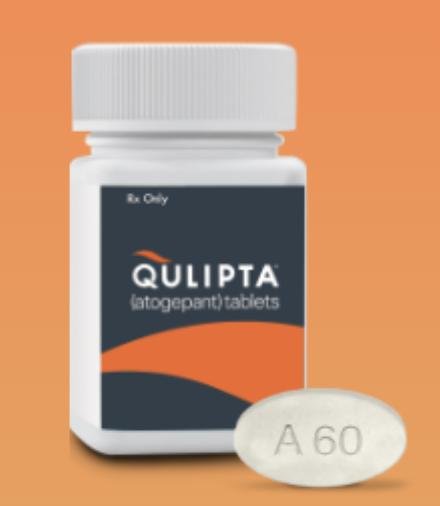Qulipta and Alcohol/Food Interactions
There is 1 alcohol/food/lifestyle interaction with Qulipta (atogepant).
Atogepant Food/Lifestyle
Moderate Food Interaction
MONITOR: Coadministration with grapefruit products or green tea, inhibitors of CYP450 3A4, may increase the plasma concentrations of atogepant, which is primarily metabolized by the isoenzyme. When atogepant was administered with the potent CYP450 3A4 inhibitor itraconazole in healthy study subjects, atogepant peak plasma concentration (Cmax) and systemic exposure (AUC) increased by approximately 2.2- and 5.5-fold, respectively. However, moderate and weak inhibitors may interact to a much lesser extent. Population pharmacokinetic modeling has suggested that moderate (e.g., cyclosporine, ciprofloxacin, fluconazole, fluvoxamine, grapefruit juice) or weak (e.g., cimetidine, esomeprazole) CYP450 3A4 inhibitors may increase atogepant AUC by 1.7- and 1.1-fold, respectively. The changes in atogepant exposure when coadministered with moderate or weak CYP450 3A4 inhibitors are not expected to be clinically significant.
MANAGEMENT: Caution is advised for patients taking atogepant and consuming grapefruit products, large amounts of green tea beverages or green tea extract. Patients should be monitored for nausea, constipation, and fatigue.
References (3)
- (2025) "Product Information. Aquipta (atogepant)." AbbVie Ltd
- (2025) "Product Information. Qulipta (atogepant)." AbbVie US LLC
- (2025) "Product Information. Qulipta (atogepant)." AbbVie Corporation
Switch to consumer interaction data
Qulipta drug interactions
There are 208 drug interactions with Qulipta (atogepant).
Qulipta disease interactions
There are 2 disease interactions with Qulipta (atogepant) which include:
More about Qulipta (atogepant)
- Qulipta consumer information
- Check interactions
- Compare alternatives
- Pricing & coupons
- Reviews (190)
- Drug images
- Side effects
- Dosage information
- During pregnancy
- Support group
- FDA approval history
- Drug class: CGRP inhibitors
- Breastfeeding
- En español
Related treatment guides
Drug Interaction Classification
| Highly clinically significant. Avoid combinations; the risk of the interaction outweighs the benefit. | |
| Moderately clinically significant. Usually avoid combinations; use it only under special circumstances. | |
| Minimally clinically significant. Minimize risk; assess risk and consider an alternative drug, take steps to circumvent the interaction risk and/or institute a monitoring plan. | |
| No interaction information available. |
See also:
Further information
Always consult your healthcare provider to ensure the information displayed on this page applies to your personal circumstances.


